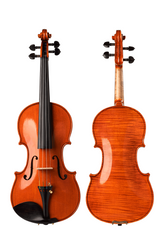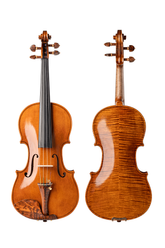When and Where Was the Violin Invented?
The violin is one of the most famous string instruments in the world, known for its emotional depth and adaptability. Its rich history stretches back to the early 16th century in Northern Italy, during the Renaissance—a period celebrated for its cultural and artistic achievements. The violin’s invention was not an isolated event but the culmination of centuries of evolution in musical instruments, craftsmanship, and creative expression.
How Did the Violin Come About?

The violin evolved from earlier string instruments that were popular across medieval Europe. Instruments such as the medieval fiddle, the rebec, and the lira da braccio laid the groundwork for its creation. These instruments, with their bowed strings and distinct tonal qualities, were widely used in folk music, religious ceremonies, and courtly entertainment.
Cremona, a city in Northern Italy, became a focal point for the violin’s development. This region’s thriving artisan community included highly skilled luthiers—craftsmen specializing in string instruments. These luthiers experimented with designs, materials, and techniques, creating instruments with greater tonal range and resonance. The violin emerged as a refined and versatile instrument, uniquely suited to meet the demands of Renaissance musicians.
Andrea Amati: The First Violin Maker
Andrea Amati, a master luthier from Cremona, is credited with inventing the modern violin around 1550. Drawing inspiration from earlier instruments, Amati developed a new design featuring four strings tuned in perfect fifths (G, D, A, E). This tuning expanded the instrument’s range and allowed for greater melodic and harmonic complexity.
Amati’s violins quickly gained widespread recognition, especially among the European elite. In 1560, King Charles IX of France commissioned Amati to produce 24 violins for his royal court. These instruments, adorned with intricate decorations and exquisite craftsmanship, elevated the violin’s status as a symbol of sophistication and artistic achievement.
The Golden Era of Violin Making
The 17th and 18th centuries are often referred to as the golden age of violin making. This period saw remarkable innovations in design and craftsmanship, particularly in Cremona. Prominent luthiers like Antonio Stradivari, Giuseppe Guarneri, and members of the Amati family refined the violin’s construction to achieve unparalleled sound quality.
Antonio Stradivari, perhaps the most famous luthier of all time, produced violins that are still regarded as masterpieces. His instruments are celebrated for their rich tonal complexity, powerful projection, and exquisite aesthetic detail. Similarly, Giuseppe Guarneri’s violins, known for their darker and more robust sound, continue to captivate musicians and collectors alike. These legendary instruments remain some of the most sought-after and valuable in the world today.
How the Violin Became a Global Instrument
The violin’s appeal transcended national and cultural boundaries, spreading rapidly beyond Italy. By the 17th century, it had become a central instrument in orchestras, chamber ensembles, and solo performances across Europe. Its adaptability allowed it to integrate seamlessly into various musical genres, including Baroque, Classical, and Romantic styles.
In addition to classical music, the violin found a place in folk traditions, from Irish reels to Eastern European dances and Indian classical music. Its expressive potential and versatility made it a favorite among composers, performers, and audiences worldwide. Over time, the violin also became a staple in contemporary music, including jazz, pop, and film scores, further solidifying its global influence.
Why the Violin Matters Today
The violin’s invention in 16th-century Italy marked a transformative moment in the history of music. Andrea Amati’s pioneering design, later perfected by Stradivari and Guarneri, created an instrument capable of extraordinary emotional and technical expression. Today, the violin continues to inspire musicians across all genres, from orchestral soloists to street performers.
Beyond its musical contributions, the violin symbolizes human ingenuity and artistry. Its construction requires a delicate balance of science and art, as luthiers carefully select woods, craft precise shapes, and tune each component to perfection. The enduring legacy of the violin reflects not only its technical evolution but also its profound impact on cultures and societies worldwide.
As the violin remains a beloved instrument, its history serves as a reminder of the timeless connection between music, craftsmanship, and the human spirit. Whether played in a grand concert hall or a small village square, the violin continues to captivate and inspire, making its story one of the most enduring in the world of music.





